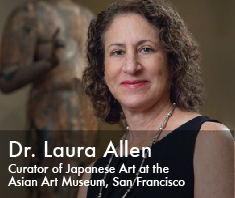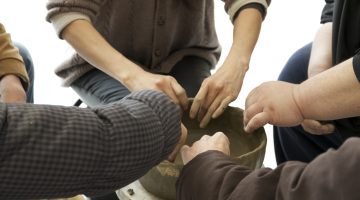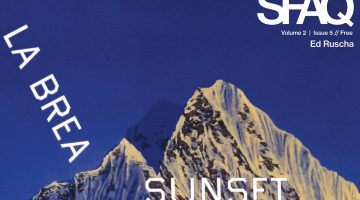Conducted by John Held, Jr.,
July 17, 2012.
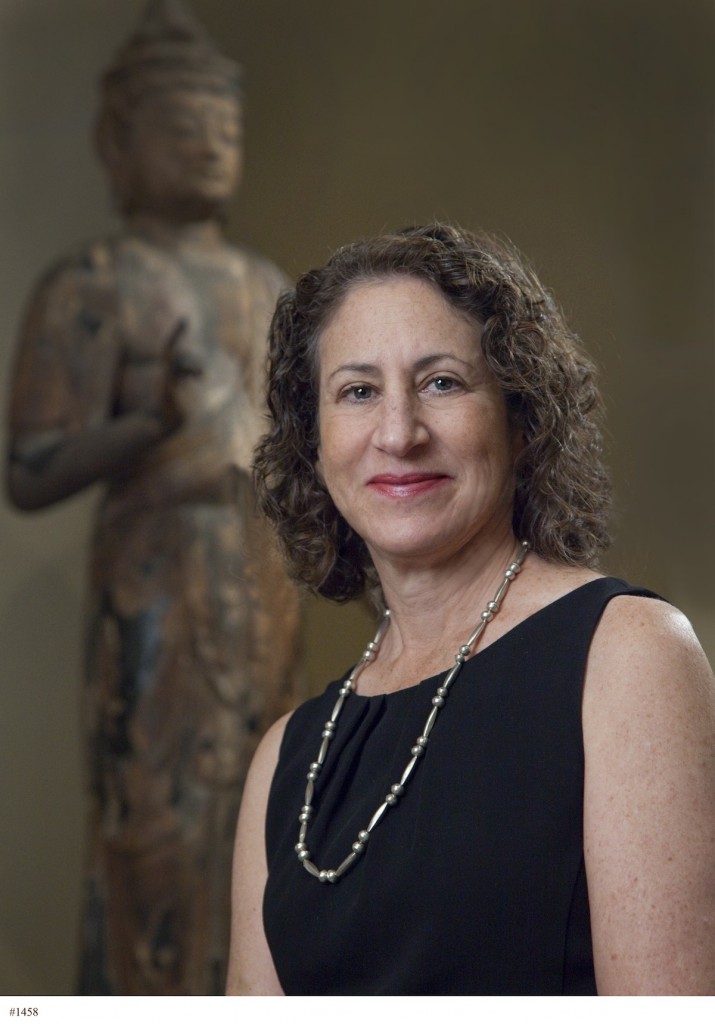
Dr. Laura Allen, Curator of Japanese Art. Asian Art Museum, San Francisco. Courtesy of the Asian Art Museum, San Francisco
John Held, Jr: Congratulations on your recent appointment, which I believe took place on June 11?
Dr. Laura Allen: Thank you. Yes, that’s right. I’ve been here a little over a month.
Held: You had been associated with the Asian Art Museum previous to your appointment.
Allen: I’ve been working with the Museum since 2006 on a variety of different projects. The first step was teaching the docents. There’s an incredible docent group here at the Museum. They have a three-year training period. I was leading the Japan year, and all those people are still around and leading great tours in the Museum.
The next project started in the fall of 2009, after my predecessor Yoko Woodson retired. There was a plan to do a show in conjunction with the 150th anniversary of the arrival of the Kanrin Maru, which brought the first “unofficial embassy” from Japan to the United States. At the time, the Associate Curator, Melissa Rinne was developing the exhibition. It was called “Japan Early Ambassadors to San Francisco,” and the part I developed was an introduction to several artists who came from Japan and worked in San Francisco as painters from about 1880 to 1927, which was the end date for the show. I don’t know if you’re familiar with Chiura Obata? He was probably the best-known artist born in Japan working in the Bay Area during that time period.
Held: I think I saw some of his work recently at the De Young. A sunset…
Allen: …sunset over Sacramento.
Held: Absolutely gorgeous. I want to explore this topic of “Western” and “Japanese” painting and the dichotomy between the two, but first I wanted to get to your academic background, which is pretty impressive.
Allen: Well, thank you. I did my Ph. D. here at Berkeley. I studied early narrative painting. The focus of my dissertation was the study of hand scroll painting, illustrated scrolls of the life of a poet monk named Saigyo. His poetry has been admired by people like Gary Synder and others. Saigyo himself is fairly well-known. It’s a 13th century painting of his life story. He renounced his daily life and took up a life of wandering. The scroll shows him moving from landscape to landscape, traveling throughout Japan and composing poetry. So, my training is really in early Japanese painting.
Held: When you were at Berkeley, you studied with James Cahill?
Allen: Yes, James Cahill, he’s a specialist in Chinese painting and also taught courses on Japanese literati painting. I also studied with Marybeth Graybill, who’s now a curator at the Portland Art Museum. She was teaching Japanese Art at that time.
Held: Previous to that you were at Oberlin College.
Allen: Yes. Actually I spent a few years in New York between the two at NYU, the Institute of Fine Arts. I studied Buddhist sculpture there under Alexander Soper, who is an eminent scholar of ancient Chinese and Japanese art.
Held: Were you interested in Japanese art history when you were an undergraduate at Oberlin?
Allen: I had pretty much decided by the time I got to Oberlin that I wanted to go to Japan, and I wanted to study art history. So, I put together the two fairly early on.
Held: Was Ellen Johnson, the head of the art museum, still there while you were at Oberlin. She was a leading museum professional of the era.
Allen: She had left right before I got there. So, I heard a lot of stories about Ellen Johnson
Held: The Institute of Fine Arts has always confused me. Is it a school, a research laboratory?
Allen: It’s a little bit odd, because it’s the graduate program for New York University art history, but it’s not downtown. It’s on the Upper East Side – the Doris Duke mansion, a big beautiful mansion on East 78th Street.
Held: While in New York, you were also at the Metropolitan Museum of Art?
Allen: I was a curatorial intern at the Met under Julie Reich. She was the curator at the time.
Held: You were working in the Japanese section?
Allen: I was working on Meiji period woodblock prints – that was the time when Japan first came into contact with the West – a collection assembled by Lincoln Kirsten. I did a lot of research on the costumes, the clothing they were wearing in those prints.
Held: At some point you obtained a Fulbright scholarship.
Allen: That was after I went to Berkeley. I did my course work for the doctorate, and applied for a grant to go to Japan. I received a Fulbright for a year in Japan.
Held: Was that the first time you had been there?
Allen: No. I had spent a year before in college.
Held: In Tokyo, or elsewhere?
Allen: I’m very lucky. I got to spend the first year in Kyoto, and the second year in Tokyo. I got a taste of both places.
Held: How was your time taken up with the Fulbright Fellowship? What was your research topic?
Allen: The Fulbright Fellowship was for dissertation research, on that hand scroll – the illustrated life of Saigyo.
Held: Your first teaching position was at the University of California at Irvine?
Allen: I taught at UC Irvine for four years.
Held: And then went to Berkeley?
Allen: I’ve never been a full time faculty member at Berkeley, but I’ve taught courses on and off at Berkeley since 1992.
Held: And also at the University of San Francisco?
Allen: As an adjunct professor at the University of San Francisco…I’ve also taught for a year at Stanford, courses at Davis, and so on…
Held: Courses on?
Allen: Usually Japanese art and occasionally survey courses on Asian art. Most recently, I’ve been an adjunct faculty member at the University of San Francisco, where I was teaching Asian art surveys.
Held: So what are your plans for the current position?
Allen: Well, there are a lot of exciting things going on at the Museum. It’s a really good time to be here. There is a really good new direction [at the Asian Museum] trying to look across cultures and across time, and involve people in Asian art and its connection to the contemporary moment. So, I’m really excited to be here for that reason. It’s also a fantastic collection – especially in the area of Japanese art, I’m happy to say.
The first project that I’m working on right now is completing the catalogue for the Grabhorn Collection of ukiyo-e prints. Now, Edward Grabhorn is very well known in San Francisco. For decades, he was the preeminent publisher of finely printed books in The City. Probably through his interest in printing, he became interested in Japanese woodblock prints and started collecting in the late 1920s, continuing into the sixties. In 1995, the Museum received a donation of about 140 prints from the Grabhorn Collection. Melissa Rinne and I have been working for about a little over the year putting together a catalogue of that collection, which is going to be released at the end of this year. So, that is one project I’ve been working on.
Held: What time period are these prints?
Allen: These are 18th century prints, and there are also some 19th century prints.
Held: In the 19th century, things began to change in Japanese art, when the artists had more contact with Western artists. And I believe a split began to develop between traditional Japanese painting and what was called “Western” painting. The Japanese artists obviously had an effect on Western artists in the late 19th century with what became known as Japonisme. What was the effect of Western art on Japanese culture during that same time period?
Allen: There were many artists that were very engaged with Western art at that time. Starting as early as the 1850s, there were many artists who were studying Western style oil painting. It actually began before that. For example, you can look at prints from the first few decades of the 19th century by artists like Kuniyoshi and Hokusai, who were very influenced by Western engraving, particularly Dutch engravings that were known in Japan in the early decades of the 19th century. Drifting clouds in the sky – this is not actually an element that is traditional to Japanese painting, but something they adopted from Western sources. The interest in Western art goes back even farther, well into the 18th century.
It goes back earlier, but you are right in saying that in the late 19th century, after the opening of Japan – after Perry came and forced the opening for trade – many artists in Japan became fascinated by oil painting and were studying pencil drawing. Obviously, the pencil was not the traditional tool for sketching in Japan. It would have been the brush. Pencil drawing was studied. Oil painting techniques were studied. There was clearly a two-way influence and effect between the two cultures. The artists who were in Japan were also going to the West and studying in France and the United States from the 1880s on.
Held: One of the Japanese artists who went to France around the 1920s was the painter Foujita. When he returned to Japan, he had a big influence on other artists, including Jiro Yoshihara, the leader of Gutai. Even before that, Japanese artists had gone to Paris and witnessed the activities of the Dada artists, and they brought back a movement called Mavo.
Allen: Of course I’m far from being an expert on modern Japanese art, but I think the thing that’s really important to keep in mind is that throughout this period in the 1910s and the 20s, in addition to going to Europe and the United States, Japanese artists were receiving publications from the West. So, they kept current with all the art movements that were happening, particularly in Paris. They were very much au courant with whatever movements were happening and were influenced by them, from the late nineteenth century on..
Held: It seems characteristic of Japanese art that groups would form, associations to study a particular aspect of art, whether it be calligraphy or Western modernism. Do you find that to be true?
Allen: There is a tendency for artists in Japan, ever since the Meiji Period, to form artistic associations. Artists could become members of multiple groups. They were not mutually exclusive. But it’s a mechanism often for being able to exhibit. By joining together in a group, the artists were able to find venues to exhibit and become better known. There were also study groups, which is quite often the case.
One artist I’m interested in is Onchi Koshiro, probably the leading print maker of the self-carved print (sosaku hanga) movement. He had gatherings called First Thursday Society meetings at his home, where people would meet and study Western artists’ work, talk about their own work, and develop manifestos defining their vision for the future of printmaking. There was a lot of that kind of collaborative activity among artists during the first half of the 20th century.
Held: You mentioned they gathered together for exhibition possibilities. Were there art galleries supporting Western style artists?
Allen: There were big public venues. There were nationally sponsored exhibitions. There were a lot of those. It’s not quite correct to say there were no venues for them to exhibit. There were smaller venues, for instance, spaces within department stores to exhibit. One artist that I’ve written on, she and her fellow painters exhibited at Takashimaya department store in downtown Tokyo, and that was a commonplace thing to do. They also exhibited at a space in Ueno Park where the National Museum is today. So, there were a variety of different venues available to them. The national exhibitions were juried, so you had to be a member of the right group, and maybe paint in the right way in order to get in.
Held: And the right place, as well. In my study of Gutai, which was an Osaka/Kobe based movement, they were often disregarded within the country, because Tokyo was the center of art, much as New York functions in this country.
Allen: They developed as a regional group.
Held: …a regional group that was trying to reach out to the rest of the world through their self-produced Gutai magazine. Were there other such groups producing periodicals?
Allen: There were an incredible variety of publications, from pamphlets distributed at a group exhibition to many art journals with art reviews and criticism, all the way up and down the scale from popular to specific audiences.
Held: I know that I’ve put you on the spot somewhat talking of contemporary art, when your background is in historic antiquities. Can you mention several artifacts in the collection that you are particularly drawn to?
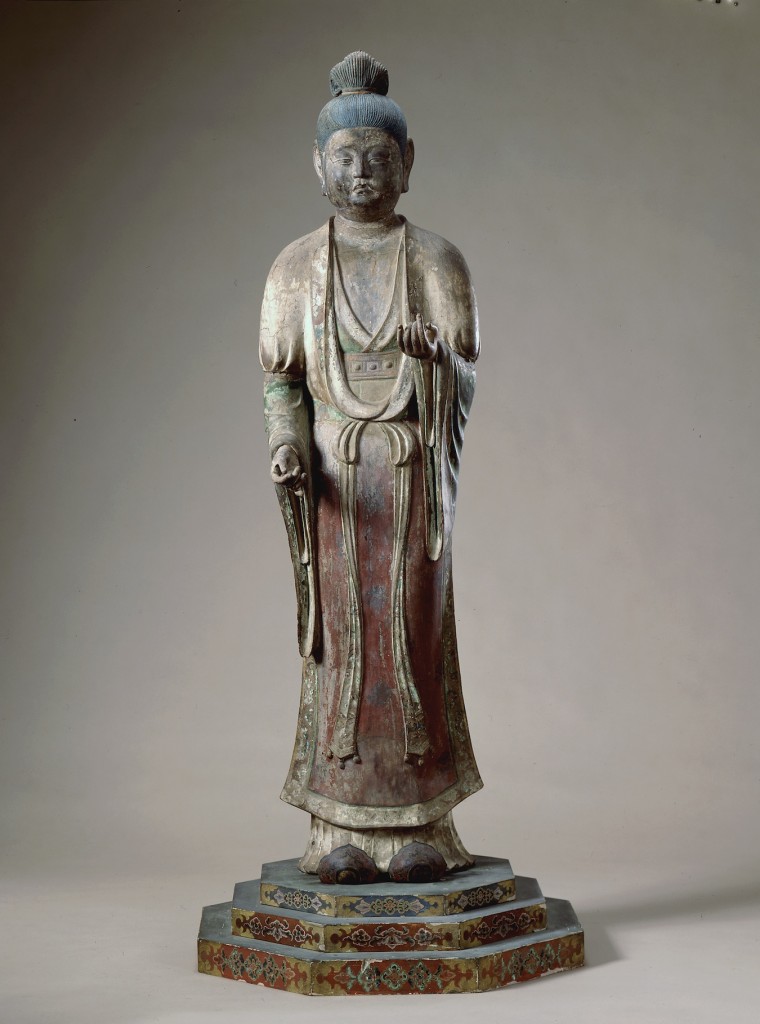
Standing Brahma (Bonten) , one of a pair, 710-794. Japan; Nara. Lacquer. The Avery Brundage Collection.
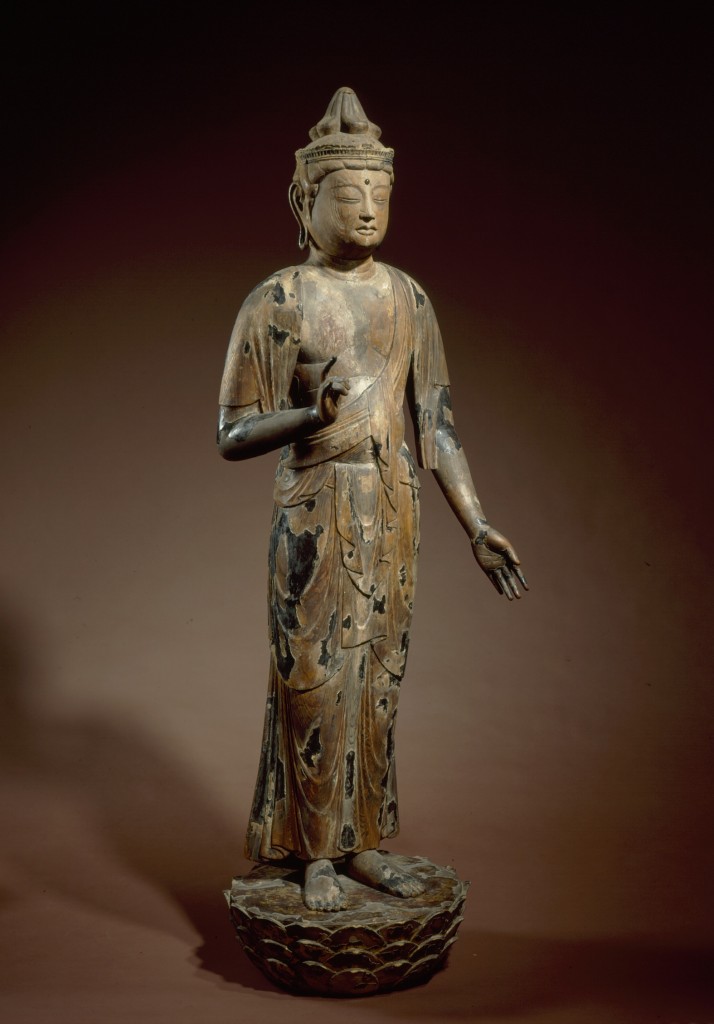
Standing bodhisattva Avalokiteshvara (Sho Kannon), approx. 794-1185. Japan. Wood with traces of lacquer and gilding. The Avery Brundage Collection.
Allen: That’s very easy. There are paintings that you can go downstairs and see today that are really marvelous. We have regular rotations of paintings, s if you schedule your visits right, you can see two different sets of painting every year, roughly in spring and summer, then another set in the fall and winter. A pair of Dragon and Tiger screens on display right now are a particular favorite. Among the Buddhist sculpture, there are outstanding examples, for example, the Bonten and Taishakuten, suburb works of 8th century sculpture. They are dry lacquer, a very fragile, delicate medium. Those are really spectacular. The Amitabha Buddha of the Western Paradise, is one I am particularly attached to. Sho Kannoon, which is directly across from it, is extremely elegant and beautiful, as well as being an image connected to compassion and mercy. That’s why I had it selected for my official photo. It’s standing behind me – giving me moral support.
There are beautiful baskets in the collection, as you know. There are also some wonderful ceramics. Among the ceramics I especially like is a kutani ware plate with a design of fern shoots and pines against a brilliant yellow. I could walk through the galleries and point out other things, if you have time.
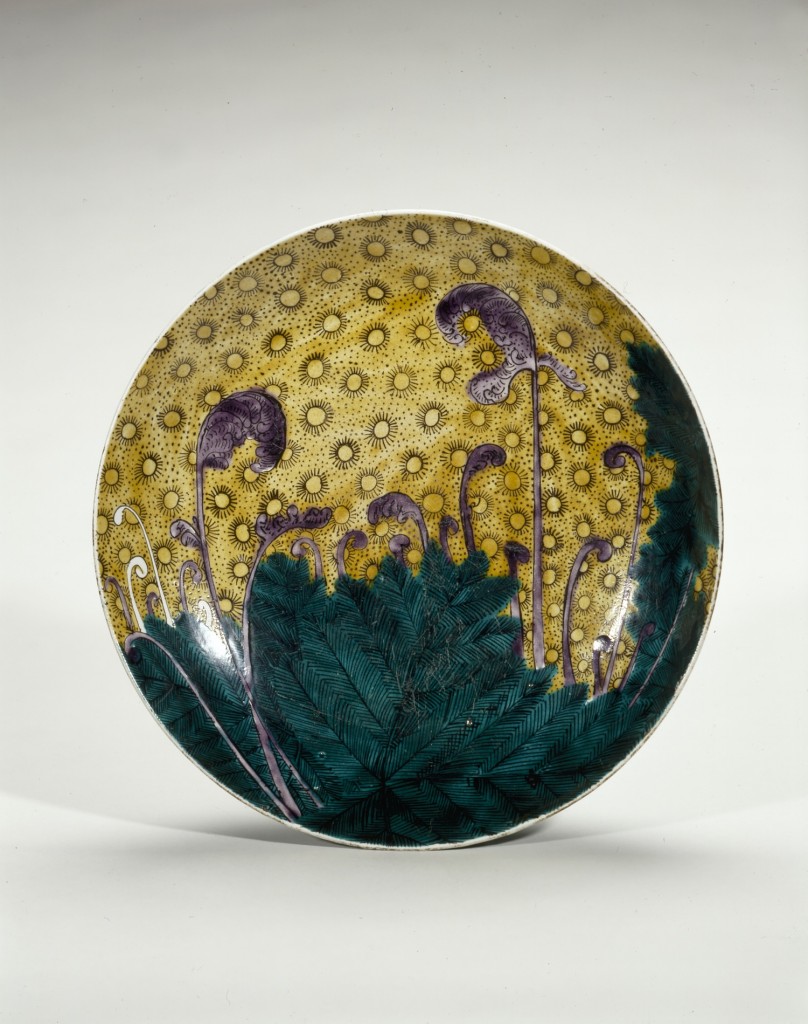
Plate with fern design, approx. 1650-1700. Japan; Arita region, Saga prefecture. Porcelain with polychrome enamel. The Avery Brundage Collection.
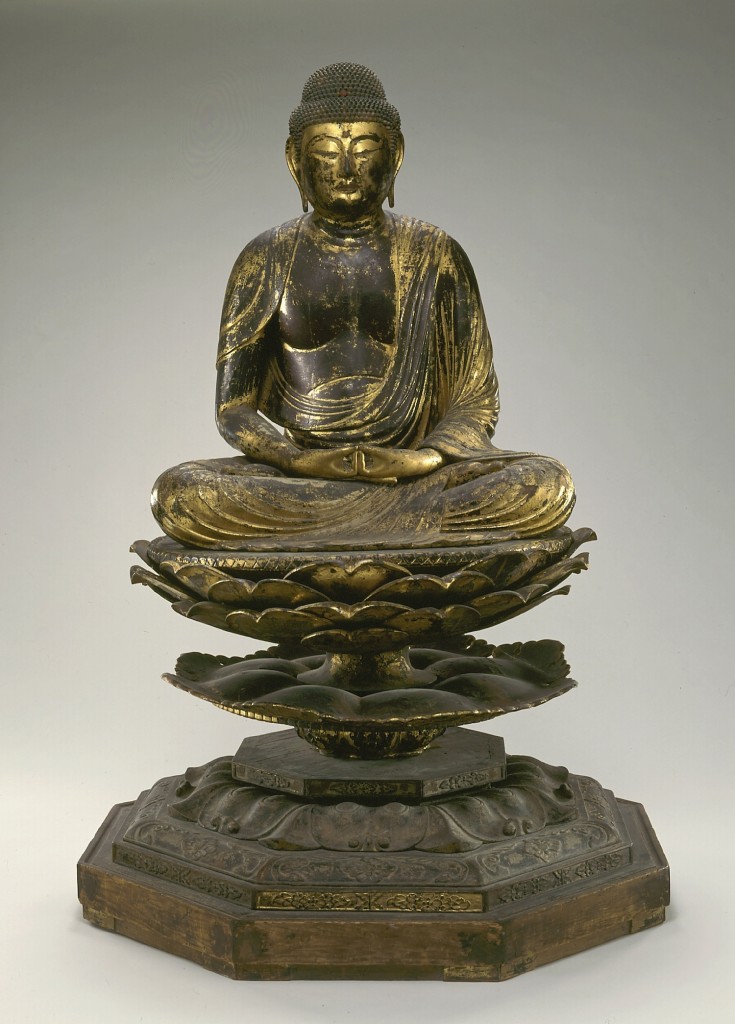
Seated buddha Amitabha (Amida), 794-1185. Japan. Lacquered and gilded on wood. The Avery Brundage Collection.
Held: I’m wondering if there is much research material that the Museum owns –not the artworks, but exhibition announcements, posters – ephemera that can be used by researchers.
Allen: We have a library that houses this material. One thing that you might not know, that I think is quite fascinating is that the kickoff exhibition for the new Museum was a show of contemporary Japanese art – a little known fact – and I think one of the major works in the exhibition was by [Gutai artist] Yoshihara Jiro –one of his circle paintings. So we’ve had a presence of contemporary art from the very beginning.
Held: Was it organized by the Museum, or was it a traveling exhibition?
Allen: It was a traveling exhibition. It opened in New York and then came here. It was an exhibition called, “Japanese Art Festival.”
Held: Do you see any other contemporary exhibitions in the future?
Allen: I hope so. I think contemporary art is going to be incorporated into a lot more of the work we do here. I’m interested in doing a show that has to do with Japanese design and that would have contemporary components in it. We are always looking for opportunities to have contemporary artists respond to the work in the collection, and to respond to particular pieces that are included in ongoing exhibitions. I’m interested in the ways that art produced in Japan inspires creative activity around the world.
By the way, we’re going to have a major exhibition next year, works owned by a local collector. It’s still a work in progress, but some major works of screen painting, hanging scrolls, Buddhist sculpture, religious sculpture and metalwork will be included. That’s going to be a big thrust of our effort in the year to come.
As I said, it’s a very exciting time to be here, because contemporary work is coming into play much more than it was ten years ago, and because the museum is actively rethinking its role in the community.
